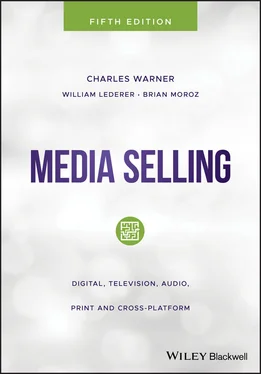However, the birth and unprecedented growth of Internet advertising reduced the leverage of television and radio stations by expanding to virtual infinity the amount of available advertising inventory. This expansion changed the marketing ecosystem from one of scarcity before the Internet to one of abundance, and when Google introduced the self‐serve online auction model with AdWords, iii advertisers had direct access to advertising inventory on which the auction market, not media sales management, set ad prices that were affordable and guaranteed to run as ordered.
Google, then Facebook and other Internet advertising platforms, led the way to a different approach. Instead of an old‐fashioned media sales department’s focus being internal – to maximize revenue – a contemporary media sales department’s focus has to be external – on a customer’s success.
New approach 3: Selling as educating
Adopting serving‐the‐customer and focus‐on‐customer‐success approaches led to a third new approach to selling in the digital era, that of selling as educating.
Media Selling, 4th Edition recommended a systematic approach to selling that broke down the sales process into six steps: (1) prospecting, (2) identifying problems, (3) generating solutions, (4) presenting, (5) negotiating and closing, and (6) servicing. These steps have changed because of the disruptions caused by the Internet. You have learned from reading about The Challenger Sale research above that the identifying problems and generating solutions steps are no longer viable in the digital‐era selling process because they put too much burden on prospects who do not have time for answering questions about their problems to which salespeople can offer ready‐made solutions. Prospects want customized solutions, but only after they understand more about the complexities and possibilities of advertising in the digital age.
Virtually all media selling today includes some element of cross‐platform selling, for example selling both the print and digital editions of The New York Times . Therefore, the old presenting step of selling has been replaced by an educating step because the presenting step was based on an assumption that prospects were familiar with the medium being presented and were able to evaluate one‐size‐fits‐all solutions.
An educating step makes no such assumption and focuses on teaching prospects about the complexities and opportunities of digital or cross‐platform advertising. Also, prospects and buyers want to be kept up to date on the rapidly changing media ecosystem and technology. In a 2018 column in Radio Inc , Beasley Broadcasting’s VP/Sales, Bob McCurdy writes:
I recall several years back when Kim Vasey, a Senior Partner Director of Radio at GroupM addressed our sales staff and reinforced this message, stressing the need to continue to “educate and re‐educate” clients and ad agencies, citing turnover and the difficulty of staying on top of all the new developments in media. This challenge is even more acute in 2018. 19
Therefore, educating and re‐educating prospects, customers, planners, and buyers not only meets the needs of those selling media but also meets the needs of those buying media.
New approach 4: Algorithms and AI are the competition
Because the majority of mobile, online, and soon television, radio, and large, national newspaper ad inventory will be bought programmatically by artificial intelligence (AI) and algorithms, a media salesperson’s biggest competition is not other media salespeople, it is the algorithms in AI applications. There are three choices today for buying advertising: (1) buy programmatically indirectly via a network of third‐party providers, (2) buy programmatically direct from publishers or buy by means of an online, automated, self‐serve auction (e.g. Google, Facebook), or (3) buy through a salesperson. If advertising buys are made programmatically or on an online auction, algorithms do the bidding, do the negotiating, complete the transactions, serve the ads, and optimize the creative – untouched by human hands…or hearts.
Media salespeople must ask themselves, “What can I, as a human, offer that artificial intelligence cannot?” Algorithms and AI are “designed to work in a rigid environment.” 20 Human beings prefer to connect emotionally with other human beings; AI cannot do that. “Humans are able to make analogies or recognize similarities in different contexts,” which gives them much better judgment and allows them to be flexible. 21 AI is not yet warm or cuddly or flexible and does not know how to connect emotionally to a prospect or buyer; therefore, salespeople have an obvious advantage – they can laugh with buyers when the buyers are happy, they can cry with prospects when the prospects are unhappy, they can hug a customer when the customer needs a hug. AI can only deal with data. AI cannot give hugs…yet, although AI applications such as IPsoft’s Amelia are getting closer to connecting emotionally every day with applications such as sentiment analysis and tone analysis (see IBM’s Watson Tone Analyzer at https://www.ibm.com/watson/developercloud/tone‐analyzer/api/v3/curl.html).
In later chapters you will learn how to understand people and their personal needs, and how to connect with them emotionally.
Mission, Objectives, Strategies, and Tactics
The transition to an Internet‐dominated, digital economy created a shifting emphasis for media salespeople from that of selling and getting an order toward one of building relationships, solving problems, and educating customers based on insights coming from analyzing data. Meanwhile, there was less time available for preparation, planning, and purchasing as advertising campaigns ran for shorter and shorter periods of time, and buyers often wait until the last minute to place schedules or buy programmatically.
The new approaches explained above also require an understanding of a hierarchical set of concepts: a sales organization’s mission, objectives, strategies , and tactics . As in any military or business organization, in a sales organization the salespeople must understand these four concepts and follow their precepts in order to have consistent and meaningful selling‐as‐serving, focus‐on‐customer‐success, selling‐as‐educating, and connecting‐emotionally approaches.
Another important reason for emphasizing a sales organization’s mission that includes such values as selling‐as‐serving, focus‐on‐customer‐success, and selling‐as‐educating is because having a job that is serving‐oriented and meaningful is what a large majority of young people entering the job market today are looking for. A 2018 Harvard Business Review article titled “9 out of 10 people are willing to earn less money to do more‐meaningful work” details the many advantages to companies of providing meaningful, purpose‐driven work to employees. 22
However, before a sales organization (division or department) can articulate sales‐specific mission, objectives, strategies, and tactics, it must answer the purpose question about the company or organization it is a part of. The purpose question is, “What is our reason for existence?”
Peter Drucker’s view of a company’s only purpose being “to create a customer” was written in 1954, and was helpful for businesses in that era, but people and their needs have changed over the 65 years since Drucker made that often‐quoted statement. Drucker’s intent almost certainly was to shift businesses, particularly manufacturing businesses, from an internal, production‐focused approach to an external, customer‐focused, marketing‐oriented approach, which many of them subsequently did. In the 1970s, 1980s, and 1990s, most major businesses took a customer‐focused, marketing approach to their businesses.
Читать дальше












